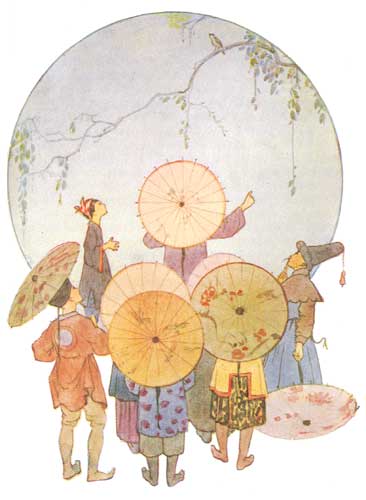
Illustration: Sur la Lune Fairytales
“Something, it appears, may be learnt from books.”
Published in 1844, “The Nightingale” tells the story of a Chinese Emperor who learns from a book about his land that there is a bird in the woods just outside his garden who sings so beautifully it is truly the treasure of the kingdom. When he orders a nightingale brought to him, a kitchen maid leads the court to thewhere the bird is found. On the way, the courtiers hear a cow and frogs, and the girl has to tell them those are neither is the song of the nightingale. When asked, the nightingale agrees to appear at court. The Emperor is so delighted with the bird’s song that he keeps the nightingale at court in its own golden cage. It is let out occasionally, but can only fly with ribbons attached to its legs. When the Emperor is given a bejeweled mechanical bird he loses interest in the real nightingale, who escapes to the forest. The mechanical bird eventually breaks down.
Five years later, the Emperor is taken deathly ill. He is presumed dead. When the real nightingale learns of the Emperor’s condition, it returns to the palace to sing for him. Death is so moved by the nightingale’s song that he departs and the emperor recovers. The nightingale agrees to sing to the emperor of all the happenings in the empire, that he will be known as the wisest emperor ever to live. The nightingale flew away, but agreed to return when it chose to sing for the king.
“The servants now came in to look after the dead emperor; when, lo! there he stood, and, to their astonishment, said, ‘Good morning.'”
I’ve mentioned this before, but I love the writing in Andersen’s stories. It is so descriptive and beautiful, almost poetic.
Apparently this tale was inspired by Andersen’s unrequited love for singer Jenny Lind, but for me a notable bit are that the bird’s singing is more beautiful, varied and lasting than it’s mechanical cousin. It’s the difference I think in listening to a recorded performance and seeing the performance live. The live performance has a quality that makes it more moving, or exciting, or touching that just can’t be duplicated.
The nightingale cared about the emperor’s heart, not his status, just as it cared about the lowliest fisherman, not the nobles. It makes a promise to the Emperor.
I will sing to you of those who are happy, and those who suffer; of the good and the evil, who are hidden around you. The little singing bird flies far from you and your court to the home of the fisherman and the peasant’s cot.
The Emperor will be wise because he knows the joys and sorrows of all his kingdom, not just those in the inner circle. Art can open us up to experiences beyond our own walls.
You can read the story in various places, including online here. What is your favorite Hans Christian Andersen fairy tale?
Friday’s Tales is a weekly event here at Carol’s Notebook. I would love it if you joined me. Fairy tales, folktales, tall tales, even re-tellings, share with us. If you have a link, please include it in your comment.

I like the story and your comments!
I had read this so long ago! I hardly remembered it. Thank you so much!
I always liked this story 🙂